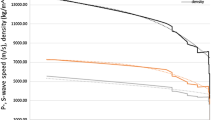Summary
Forced hydromagnetic oscillations in the outer core due to stress at its top are studied by means of a simple linear theoretical model originally proposed byHide [1] for the free oscillation studies. Both the magnetic and the inertial modes are excited. The expressions for the velocity, magnetic and vorticity fields are presented for a variety of stresses. They depend upon the wave number and frequency. In a numerical example wherein the stress varies periodically both in the space and the time, the amplitude of the induced magnetic field is found to be significant for reasonable values of various parameters.
Similar content being viewed by others
References
R. Hide,On the Earth’s core-mantle interface, Quant. J. Roy. Met. Soc.96 (1970), 579–590.
R. Hide,Free hydromagnetic oscillations of the Earth’s core and the theory of the geomagnetic secular variation, Philitrons, Roy. Soc. Lond.A259 (1966), 615–650.
M. G. Rochester,Core-mantle interactions: Geophysical and astronomical consequences, inEarthquake Displacement Fields and the Rotation of the Earth, edited byL. Mansinha et al. (D. Reidel, Dordrecht, Holland 1970), pp. 136–148.
Author information
Authors and Affiliations
Rights and permissions
About this article
Cite this article
Singh, R.N. Excitation of hide waves in the core due to transient-spatially periodic stress in the lower mantle. PAGEOPH 109, 1781–1788 (1973). https://doi.org/10.1007/BF00876104
Received:
Issue Date:
DOI: https://doi.org/10.1007/BF00876104




